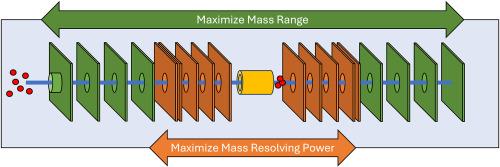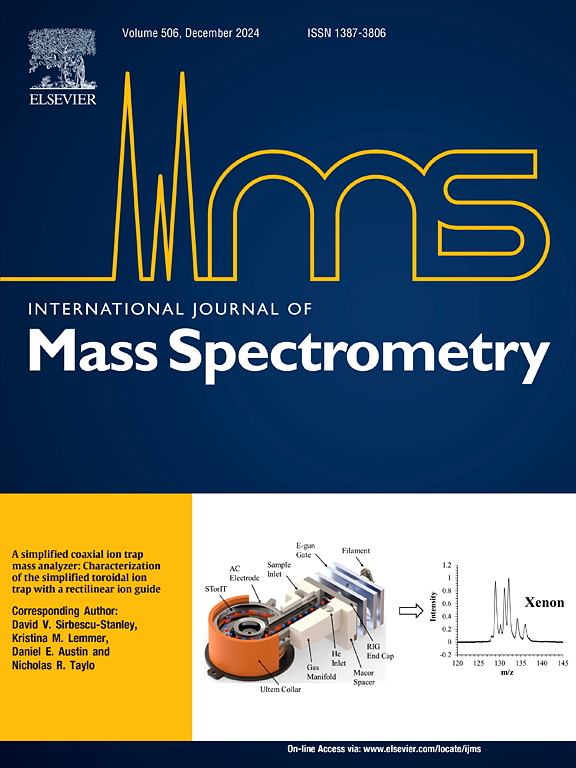Demonstration of a nested electrostatic linear ion trap for flexibility in selecting analyzer figures-of-merit
IF 1.7
3区 化学
Q3 PHYSICS, ATOMIC, MOLECULAR & CHEMICAL
引用次数: 0
Abstract
An electrostatic linear ion trap (ELIT) is used to trap ions between two ion mirrors with image current detection by central detection electrode. Transformation of the time-domain signal to the frequency-domain via Fourier transform (FT) yields an ion frequency spectrum that can be converted to a mass-to-charge (m/z) scale. Injection of ions into an ELIT from an external ion source leads to a time-of-flight ion separation that ultimately determines the range of m/z over which ions can be collected from a given ion injection step. The m/z range is determined both by the length of the ELIT and by the distance of the ELIT entrance from the ion source. A longer ELIT leads to a wider m/z range while a shorter ELIT, under equivalent conditions, leads to higher resolving power due to increased ion frequencies. Hence, there is an inherent trade-off between the two important analyzer figures-of-merit: m/z range and resolving power, based on the length of the ELIT. In this work, we demonstrate a nested ELIT arrangement, referred to herein as an NELIT, that allows for the selection of one of two possible ELIT lengths within a single array of plates while employing a common detection electrode. While a range of ELIT lengths are possible, in principle, the geometry described herein leads to an effective length ratio of 2.40 for the two traps in the NELIT.

演示了一个嵌套静电线性离子阱,以灵活地选择分析仪的性能值
采用静电线性离子阱(ELIT)在两个离子镜之间捕获离子,并采用中心检测电极进行图像电流检测。通过傅里叶变换(FT)将时域信号转换为频域,可以得到离子频谱,该频谱可以转换为质量-电荷(m/z)尺度。从外部离子源向ELIT注入离子导致飞行时间离子分离,最终决定了从给定离子注入步骤中可以收集离子的m/z范围。m/z范围由ELIT的长度和ELIT入口到离子源的距离决定。较长的ELIT导致更宽的m/z范围,而较短的ELIT,在同等条件下,由于离子频率的增加,导致更高的分辨能力。因此,在两个重要的分析仪参数之间存在固有的权衡:m/z范围和分辨率,基于ELIT的长度。在这项工作中,我们展示了一个嵌套的ELIT安排,这里称为NELIT,它允许在单个板阵列中选择两种可能的ELIT长度之一,同时使用一个共同的检测电极。虽然ELIT的长度范围是可能的,但原则上,本文描述的几何形状导致NELIT中两个圈闭的有效长度比为2.40。
本文章由计算机程序翻译,如有差异,请以英文原文为准。
求助全文
约1分钟内获得全文
求助全文
来源期刊
CiteScore
3.60
自引率
5.60%
发文量
145
审稿时长
71 days
期刊介绍:
The journal invites papers that advance the field of mass spectrometry by exploring fundamental aspects of ion processes using both the experimental and theoretical approaches, developing new instrumentation and experimental strategies for chemical analysis using mass spectrometry, developing new computational strategies for data interpretation and integration, reporting new applications of mass spectrometry and hyphenated techniques in biology, chemistry, geology, and physics.
Papers, in which standard mass spectrometry techniques are used for analysis will not be considered.
IJMS publishes full-length articles, short communications, reviews, and feature articles including young scientist features.

 求助内容:
求助内容: 应助结果提醒方式:
应助结果提醒方式:


